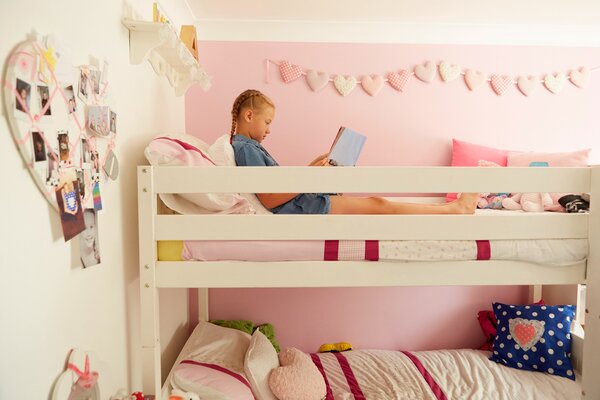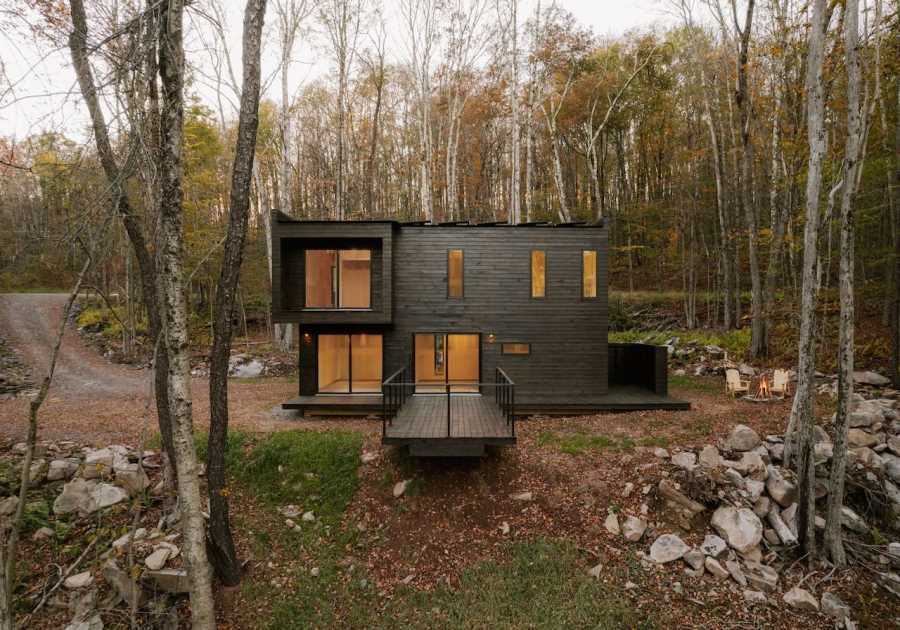Though the space-saving furniture first gained traction for utilitarian reasons, bunks became fun household luxuries thanks to shows like "The Brady Bunch."
Despite their ubiquity in so many settings, no one really knows when bunk beds were invented. Some accounts say they could have been a medieval invention, while others credit the Iroquois people of northeastern North America, who used them in their longhouses between 300 and 500 years ago as a space-saving measure for sleeping and storage. When the 1800s rolled around, the use of bunk beds started gaining traction in military barracks, jails, and in tight, moving quarters, like in train, ship, or submarine cabins. They weren’t fashionable or popular, showing up in movies more as a means to a punch line than as a reputable piece of furniture. (The Three Stooges, for instance, pulled a gag in one of their films where a creaky triple stack of wooden bunks collapsed, squishing two-thirds of the trio.) That all changed around the mid-20th century however, when, facing down the baby boom and the limitations of modern housing, more and more parents started turning to bunks.

In the 1960s and ’70s American sitcom The Brady Bunch, brothers Peter and Bobby shared a set of royal blue bunks with matching quilted comforters.
Courtesy Everett Collection
That’s probably part of the reason they showed up in The Brady Bunch, where brothers Peter and Bobby shared a set of royal blue bunks with matching comforters, or in the 1970s and ’80s sitcom Diff’rent Strokes, where brothers Arnold and Willis Jackson shared an L-shaped set made of natural wood. Midcentury TV shows like those made bunk beds a status symbol for kids, taking what was once utilitarian and making it a fun luxury. Bunks, it seemed, were a place where siblings or best friends could share heartfelt conversations or whispered secrets at night. Sleeping in the top bunk meant you’d achieved big kid status (or Big status, in the case of the 1988 Tom Hanks movie) and sleeping that high somehow offered a level of privacy—even if it also meant you could roll off at any moment and (literally) break your neck.
I never had bunk beds in my house as a kid—I had just one brother, and we never had to share rooms—but I idolized those who did. To me, bunk beds meant you could have sleepovers, something my parents were never too keen on, and seemed endlessly customizable. If I had them, I knew I’d claim the bottom, where I’d hang lights along the mattress slats above and paste up pictures of my teen idols. Bunks, it seemed, were all about possibility—and, for me, all about wanting what I didn’t have.

Bunk beds started to become popular in family households in the mid-20th century.
Emma Kim/Getty
I did eventually get access to a bunk bed at my grandma’s house, however. She splurged on a set for my brother and me, and we’d share when we were at her house for long weekends—though, as it turned out, it wasn’t all it was cracked up to be. The blocky wooden ladder rungs dug into my feet when I had to climb up and down, and she separated them into twin beds after about two visits, frustrated with how hard the sheets were to change. That same issue plagued me my freshman year in college, when I struggled to change my twin XL T-shirt sheets (de rigueur at the time, I assure you) while also kneeling atop my top bunk. I vividly remember taking tiny bunny leaps toward the ceiling just two feet away, trying to figure out how I’d ever get my sheet corners down and my flat sheet just so. There’s a reason I only washed my sheets a couple of times that year, and it’s not just because all 18-year-olds living on their own for the first time are inherently unhygienic.
That doesn’t mean the thrill of a bunk bed has died in me. I remember watching Step Brothers—which celebrated its 15th anniversary this July—and loving the scene where newly minted best friends and middle-aged stepbrothers Brennan and Dale (Will Ferrell and John C. Reilly) try to turn their grown-up beds into ramshackle bunks. I identified deeply with their desire to have room for "activities," though I was probably more interested in having space for a bean bag chair than I was in doing aerobics like they were. Unlike my parents, Brennan and Dale’s mom and dad seem totally cool with the idea, and the boys set off with scraps of wood and hastily assembled power tools, throwing together what they think is a functional set of bunks. They look fine but of course they collapse, Three Stooges–style, trapping Brennan between the top and bottom bunks much to Dale’s feverish dismay.
Brennan makes it out with just a scrape, and Dale curses the whole idea of bunk beds. You can’t blame them for trying though, because, like so many of us, they’d bought into the dream of the bunk bed and the fun, friendship, and freedom it’s come to represent. I have kids of my own now, and while I love the idea of cozying up in a family set of bunks and listening to my kids fall asleep while on some mountain vacation we’ll probably never take, I’m still absolutely positive I’ll never buy a set for our home, no matter how much my kids ask. After all, those damn sheets are just too hard to change.
Top Image: © Columbia Pictures, Courtesy Everett Collection
Related Reading:
The TikTok Girlies Reclaiming Being a "Bed Person"
An Ode to the Tiny Yet Wondrous Apartment of Charlie From "Girls"
Read More
By: Marah Eakin
Title: When Did Bunk Beds Become Childhood Status Symbols?
Sourced From: www.dwell.com/article/when-did-bunk-beds-become-childhood-status-symbols-6761af87
Published Date: Tue, 25 Jul 2023 16:51:37 GMT
.png)





